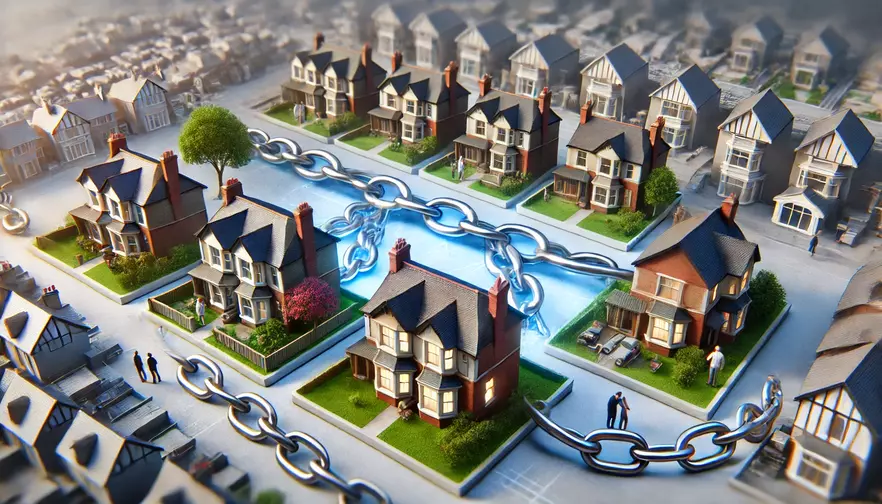What is a Property Chain?
A property chain is a sequence of linked property transactions, where each sale depends on the completion of another sale. In simpler terms, it's a domino effect where the buying and selling of properties are interconnected. For example, if you are buying a new home and need to sell your current home to finance the purchase, you are part of a property chain. If the person buying your home is also selling their property, the chain continues.
Typical property chains can vary in length. A short chain might involve just two properties, while longer chains can include several buyers and sellers, all relying on each other to complete their transactions. The more links in the chain, the more complex and potentially fragile it becomes.
How Property Chains Operate
The Buying and Selling Process in a Property Chain
In a property chain, each participant is both a buyer and a seller. The process begins when the first person in the chain decides to sell their property and purchase a new one. This sets off a sequence where each subsequent buyer must sell their property to fund their purchase.
Roles of Buyers, Sellers, and Estate Agents
Estate agents play a crucial role in managing property chains. They act as intermediaries, facilitating communication between buyers and sellers and ensuring that each link in the chain is aware of the others' progress. Buyers and sellers need to stay informed about the status of their transactions and be prepared for potential delays.
Connecting Each Link in the Chain
Each link in the chain is dependent on the others. For example, if you are buying a property and selling your current one, your purchase depends on the successful sale of your home. If the buyer of your property faces delays, it can impact your ability to proceed with your purchase, and so on down the chain.
Common Scenarios in Property Chains
Chain-Free Transactions
In some cases, you might encounter a chain-free transaction. This occurs when the buyer does not need to sell a property to finance the purchase, or when the seller is not purchasing another property. Chain-free transactions are generally simpler and less prone to delays.
Long Property Chains
Long property chains involve multiple buyers and sellers. These chains are more complex and have a higher risk of delays, as each transaction is interdependent. The longer the chain, the more challenging it can be to manage.
Breaks in the Chain and Their Causes
A break in the chain occurs when one party withdraws from the transaction or faces significant delays. Common causes include financing issues, problems discovered during property surveys, or personal circumstances changing for one of the parties. Breaks in the chain can cause delays and potentially lead to the collapse of the entire sequence of transactions.
Potential Issues and Delays
Common Problems in Property Chains
Several issues can arise in property chains. Financing problems are common, where a buyer's mortgage application is delayed or denied. Property surveys can uncover issues that require renegotiation or additional work, leading to delays. Legal problems, such as issues with property titles or disputes, can also stall the process.
Impact of Delays
Delays in one part of the chain affect the entire sequence. For instance, if the buyer of your property faces a financing delay, it can prevent you from completing your purchase on time. This, in turn, affects the seller of your new home and anyone else in the chain. Understanding this interdependence is crucial for managing expectations and preparing for potential setbacks.
Examples of Typical Delays
Typical delays include waiting for mortgage approvals, completing necessary repairs identified in surveys, and resolving legal issues. These delays can range from a few days to several weeks, depending on the complexity of the problem and the efficiency of the parties involved in resolving it.
Managing and Navigating Property Chains
Tips for Managing Your Position in a Property Chain
To manage your position in a property chain effectively, stay proactive and organised. Keep all necessary documents readily available and respond promptly to requests from your estate agent or solicitor. Regular communication with all parties involved helps ensure that everyone is on the same page and can address issues as they arise.
Effective Communication with All Parties
Maintaining clear and open communication with your estate agent, solicitor, and other parties in the chain is vital. Regular updates can help identify potential problems early and find solutions before they cause significant delays. Ensure that all contact information is up to date and that everyone knows the best way to reach you.
Role of Solicitors and Conveyancers
Solicitors and conveyancers play a crucial role in navigating property chains. They handle the legal aspects of buying and selling properties, ensuring that all paperwork is in order and that transactions proceed smoothly. Choose a solicitor with experience in managing property chains to help mitigate potential issues and keep the process on track.
What to Expect During the Process
Timeline of a Property Chain Transaction
The timeline of a property chain transaction can vary, but it typically takes several weeks to a few months to complete. The process begins with listing your property and making an offer on a new home. Once offers are accepted, the legal and financial processes commence, including surveys, mortgage applications, and contract exchanges. The final stage is the completion, where all parties move into their new homes.
Key Milestones and What Happens at Each Stage
Key milestones in a property chain transaction include:
- Listing Your Property: Preparing your home for sale and finding a buyer.
- Making and Accepting Offers: Negotiating terms and agreeing on a sale price.
- Conducting Surveys and Inspections: Identifying any issues that need addressing.
- Securing Financing: Obtaining mortgage approval for your purchase.
- Exchanging Contracts: Legally committing to the sale and purchase.
- Completion: Finalising the transaction and moving into your new home.
Finalising the Sale and Completing the Chain
Completion is the final stage in the property chain process. On completion day, the funds are transferred, and ownership of the properties changes hands. All parties in the chain move into their new homes, marking the end of the process.
Tips for a Smooth Property Chain Experience
Strategies to Minimise Delays and Issues
To minimise delays and issues, ensure all your paperwork is in order and respond promptly to any requests. Stay in regular contact with your estate agent and solicitor, and be prepared to act quickly if any problems arise. Flexibility and preparedness are key to navigating property chains successfully.
Importance of Being Prepared and Organised
Being well-prepared and organised can significantly reduce stress and delays. Keep all relevant documents accessible, stay on top of deadlines, and ensure that you understand each step of the process. A well-organised approach helps you address issues efficiently and keeps the chain moving smoothly.
Staying Flexible and Patient
Flexibility and patience are crucial when dealing with property chains. Delays and issues are common, and being prepared to adapt can make the process less stressful. Keep a positive attitude, and remember that while the process can be complex, the end result is moving into your new home.
Conclusion
Understanding property chains and how they operate is essential for navigating the UK housing market. By knowing what to expect and staying proactive, you can manage your position in a property chain effectively. Remember to stay organised, communicate clearly, and remain flexible to ensure a successful transaction. With the right approach, you can navigate property chains smoothly and move into your new home with confidence.




